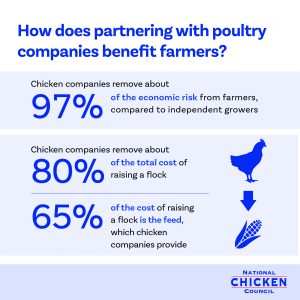In the U.S., chicken is king among all animal protein options because it’s affordable, safe, nutrient-dense and delicious. In fact, the average American consumes nearly 100 pounds of chicken per person, each year. This equates to approximately 160 million servings of chicken every day.
This blog post, “Contract Farmers + Chicken Company Partnerships = Healthy, Affordable Protein,” originally appeared this week on Chicken Check In.
Without the key business partnerships between contract farmers and processing companies, chicken may not be America’s No. 1 protein. What exactly is a contract grower? A contract grower is an independent farmer who works under contract with a chicken company to raise broiler chickens, or chickens for meat. More than 90% of all U.S. chickens raised for meat are cared for by contract growers. According to a March 2022 study conducted by FarmEcon LLC, Live Chicken Production Trends, found that when chicken farmer and chicken company business partnerships are mutually beneficial, successful and profitable, consumers win big, too.


